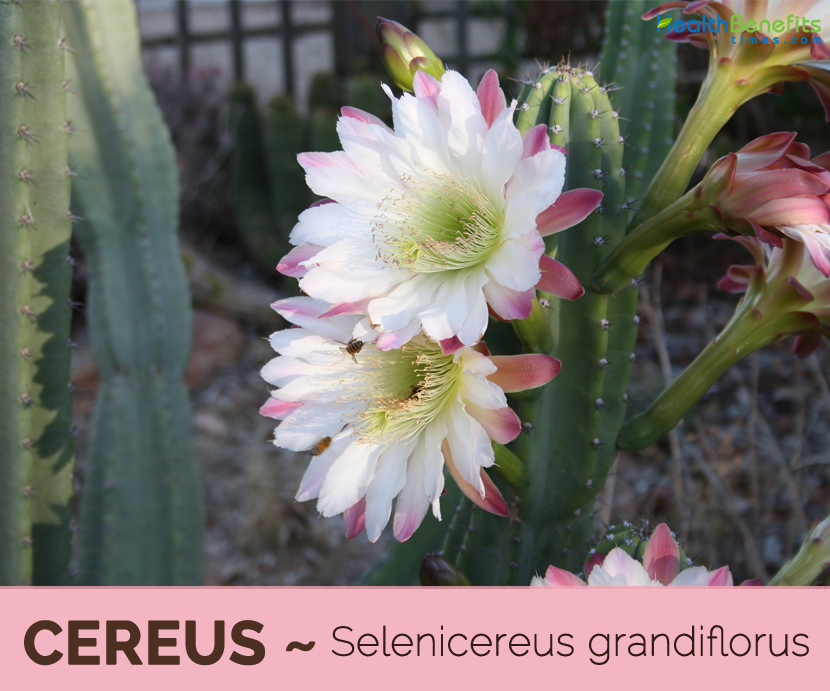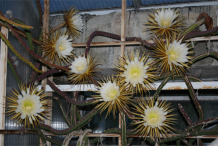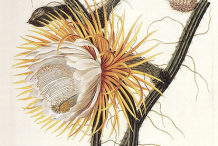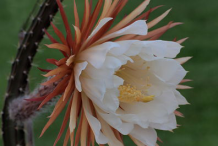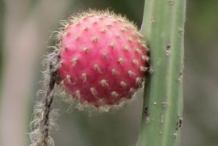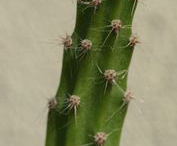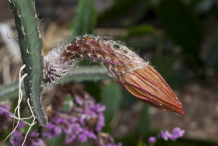Plant Descriptions
Cereus is a fleshy, creeping, rooting shrub found growing in a well-drained soil rich in organic matter. It has tuberous, turnip-like root usually weighing 5 to 15 pounds. Stem is green to bluish green, becoming purplish along ribs, to several m, 1-2.5 cm diam.; ribs 5-8, low; areoles usually 1-2 cm apart along ribs, 1-2 mm diam. The plant consists of spines that are deciduous, 6-18 per areole, whitish to brownish, ± bristle like or short acicular, 4.5-12(-15) mm, intermixed with long, whitish hairs; radial and central spines not distinguishable.
Flower & Fruit
The plant consists of fragrant trumpet-shaped flowers that are up to 4 inches wide and as much as 8 inches long. The outer petals of the flower are brown, orange or lemon yellow; the inner petals are white, oblanceolate, with an acute apex. The areoles of the ovary and flower tube bear long hair like spines. The waxy, creamy-white, many-petaled flowers are followed by an ovate, covered with scaly tubercles, fleshy, short-spined elliptical fruit about three inches long. The fruit consists of many small seeds that are acidic in nature. Night blooming Cereus will not begin to flower until it is four or five years old and will begin with just a couple of flowers. The Night Blooming Cereus Stem should be collected in July when the plant is fresh. A tincture from the Night Blooming Cereus Stem is considered to be a homeopathic treatment for many health problems.
Traditional uses and benefits of Cereus
- Indigenous peoples of America have used the night blooming cereus as a topical remedy for rheumatism and itchy rashes, as well as an internal herbal remedy for worms, cystitis and fever.
- Native American tribe Death Valley Shoshone called this plant “pain in the heart”, and used it to treat angina-like pains.
- Several other tribes of Native Americans use the stem to treat diabetes.
- Night blooming cereus has a history of use in traditional herbal medicine as a treatment for hemoptysis and edema.
- It is use as an herbal treatment for heart conditions and it is highly valued by traditional herbalists as a natural treatment for heart palpitations, angina, weak or irregular pulse, and for relieving shortness of breath.
- It is believed to be a useful natural treatment to help normalize heart rhythm and strengthens contractile force.
- It is also used by traditional herbalists as a natural treatment to tone the heart muscle, reduce blood fat and cholesterol, and increase circulation.
- It is considered to be helpful as a diuretic, a stimulating cardiac tonic, a cardiac tropho-restorative, and as a stimulant and tonic for the spinal and motor nerves.
- It has been used as a homeopathic treatment for digestive ailments with flatulence and cramp-like pains, as well as an herbal remedy for pain associated with menstrual cramps.
- It is a traditional herbal treatment for nervous disorders of all types, sea and motion sickness, low body temperature, cold sweats, and edema.
- A liquid extract of the Night Blooming Cereus Stem may also relieve shortness of breath and tobacco poisoning.
Culinary Uses
- The dried flowers of the night-blooming cereus are a common ingredient used in Cantonese slow-simmered soup.
Other Facts
- In the 15th century, Christopher Columbus brought this curative plant to Europe.
- Flower only lasts in bloom about six hours and does not revive- when withered.
- The plant contains a milky acrid juice.
Precautions
- An overdose of this herb may cause gastric irritation, a rapid and erratic heartbeat, cardio spasm or a feeling of constriction in the chest.
- It may cause slight delirium, hallucinations, and general mental confusion.
- If you are lactating or pregnant, Night Blooming Cereus Stem must not be used for any reason since it may cause fetal abnormalities and decreased blood pressure.
- If you are using any cardiac medications, ask your doctor for advice regarding Night Blooming Cereus Stem use.
- Night-Blooming Cereus lowers cholesterol and also works to sooth away inflammation of the bladder.
- Contact of juice with the mouth may result in a feeling of burning possibly associated with nausea, vomitus and diarrhea.
- Dermal contact of the fresh juice of Selenicereus grandiflorus may cause skin irritations with pruritus and pustules.
References:
https://plants.usda.gov/core/profile?symbol=SEGR10
https://www.itis.gov/servlet/SingleRpt/SingleRpt?search_topic=TSN&search_value=505117#null
https://npgsweb.ars-grin.gov/gringlobal/taxonomydetail.aspx?id=33593
https://en.wikipedia.org/wiki/Night-blooming_cereus
http://www.botanical.com/botanical/mgmh/c/cernig48.html
https://en.wikipedia.org/wiki/Selenicereus_grandiflorus
Comments
| Cereus Quick Facts | |
|---|---|
| Name: | Cereus |
| Scientific Name: | Selenicereus grandiflorus |
| Origin | Desert and semi-desert regions of the Antilles, tropical America, Mexico, and the southern United States |
| Colors | Red-orange |
| Shapes | Ovate, covered with scaly tubercles, fleshy, short-spined elliptical fruit about three inches long |
| Taste | Bitter |
| Name | Cereus |
|---|---|
| Scientific Name | Selenicereus grandiflorus |
| Native | Desert and semi-desert regions of the Antilles, tropical America, Mexico, and the southern United States |
| Common Names | Princess of the night, Honolulu queen, Christ in the Manger, Dama de Noche, queen of the night, sweet-scented cactus, large-flowered cactus, vanilla cactus, large blooming cereus, large-flowered torch thistle, lunar flower, organillo |
| Name in Other Languages | Afrikaans: Koningin van die Nag Arabic: Malikat allayl (ملكة الليل) Chinese: Dà huā shé biān zhù ( 大 花蛇鞭柱) Czech: Královna noci Danish: Nattens Dronning Dutch: Koningin der nacht. English: Night-blooming cereus, Queen of the night, Sweet-scented cactus, Vanilla cactus, maidenhair fern, Organillo, Pitayita-nocturna reina de la noche, large-flowering cactus, large flowered torch thistle, large-flowered night cactus Estonian: Öökuninganna Finnish: Yönkuningatar French: Cactus cierge à grandes fleurs, Princesse de la nuit, Reine de la nuit, cierge rampant à grandes fleurs, cierge rouge, fleur d’amour, reine de la nuit, vierge à grandes fleurs, German: Königin der Nacht, Schlangencereus, Schlangenkaktus India: Brahma Kamalam Italian: cacto grandifloro, regina della notte Japan: Gekka Bijin, Beauty under the Moon Kannada: Brahma Kamala. Malayalam: Nisha Ghanthi (Nishagandhi) (Fragrance of the Night) Marathi: Brahma KamaLa Polish: Królowa Jednej Nocy Portuguese: Rainha-da-noite, cardeiro trepador, flor de baile Punjabi: Raat di sassi Русский: Царица ночи Romanian: Cactus din Antilele Olandeze Russian: Cеленицереус крупноцветковый Selenitsereus krupnotsvetkovyi. Serbian: Carica noći (Царица ноћи) Sinhalese: Kadupul (කඩුපුල්) Spanish: Reina de lanoche, cardón, gigante, Pitayita-nocturna reina de la noche, reina de las flores, Selenicereus grandiflorus, Organillo Sri lanka: Kadupul Mal, Flower from the Heaven Swedish: Nattens drottning Tamil/Telugu : Brahma Kamalam (Lord Brahma’s Flower) Vietnamese: Hoa quỳnh |
| Plant Growth Habit | Fleshy, creeping, rooting shrub |
| Soil | Prefers a well-drained soil with organic matter |
| Root | Tuberous, turnip-like root usually weighing 5 to 15 pounds |
| Stem | Green to bluish green, becoming purplish along ribs, to several m, 1-2.5 cm diam.; ribs 5-8, low; areoles usually 1-2 cm apart along ribs, 1-2 mm diam. |
| Spines | Deciduous, 6-18 per areole, whitish to brownish, ± bristlelike or short acicular, 4.5-12(-15) mm, intermixed with long, whitish hairs; radial and central spines not distinguishable |
| Flowering Periods | June or July |
| Flower | Fragrant trumpet-shaped flowers are up to 4 inches wide and as much as 8 inches long. The outer petals of the flower are brown, orange or lemon yellow; the inner petals are white, oblanceolate, with an acute apex. The areoles of the ovary and flower tube bear long hair like spines. |
| Fruit Shape & Size | Ovate, covered with scaly tubercles, fleshy, short-spined elliptical fruit about three inches long |
| Fruit Color | Red-orange |
| Seed | Small and acidic in nature |
| Taste | Bitter |
| Plant Parts Used | Young succulent stems and flowers |


